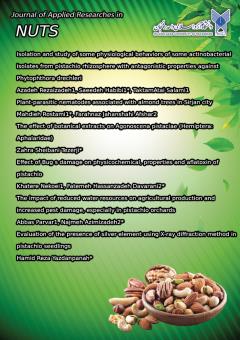تاثیر کاهش منابع آب بر تولید بخش کشاورزی و افزایش خسارت آفات به خصوص در باغات پسته
الموضوعات :
عباس پرور
1
![]() ,
نجمه عظیمی زاده
2
,
نجمه عظیمی زاده
2
1 - استادیار و عضو هیئت علمی دانشگاه آزاد اسلامی واحد جیرفت
2 - عضو هیئت علمی دانشکده کشاورزی دانشگاه آزاد اسلامی واحد رفسنجان
الکلمات المفتاحية: سیستم های خرد آبیاری , خسارت آفات, خشکسالی, کاهش تولید,
ملخص المقالة :
آب منبعي محدود و در عين حال ضروري براي جوامع بشري و سيستم اکولوژيکي وابسته به آن مي باشد و یکی از منابع مهم پایهای برای توسعه کشور و مهم ترین عامل تولید در کشاورزی است. بخش کشاورزي به عنوان بزرگترين مصرف کننده آب جهت توليد غذاي بيشتر با آب کمتر با چالش مواجه مي باشد. خشکسالی و کاهش بارندگی بیشترین تاثیر را در این بخش می گذارد و کاهش تولید در این بخش منجر به افزایش زیان در سایر بخش های اقتصادی و کاهش درآمد عوامل تولید می شود. بـا توجـه بـه اینکـه خشـکی و خشکسـالی از خصوصیـات طبیعـی و اقلیمـی ایـران اسـت و میـزان بارندگـی در کشـورمان بـه طـور متوسـط نزدیـک بـه یـک سـوم متوسـط جهانـی اسـت، تولیـد محصـول پسته در مراکـز عمـدة تولیـد آن بـا مشـکل کمبـود آب روبـه روسـت. مقدار، تناوب و شیوهی آبیاری بر تولید پسته تأثیر زیادی میگذارد. از سوی دیگر شیوع بیماریها و آفاتی که به درخت پسته حمله ور میشوند، مقدار و کیفیت محصول و رشد درخت، همگی تحت تأثیر آبیاری درخت پسته قرار دارند. سیستم های خرد آبیاری (آبیاری قطره ای سطحی، زیر سطحی و خرد آبپاشی) قادرند تا آب آبیاری را با راندمان کامل در اختیار گیاه قرار دهند، به شرط اینکه بهره برداری و مدیریت مناسب در مورد آنها اجرا گردد. در صورت ايجاد رطوبت مناسب و مدیریت آبیاری علاوه بر افزايش تحمل درخت، شرايط مناسب براي فعاليت دشمنان طبيعي فراهم مي گردد كه اين امر سبب كاهش جمعيت آفات پسته و افزایش تولید محصول پسته مي شود.
1. Abbas, A., Amjath-Babu, T.S., Kächele, H. and Müller, K. 2015. Non-structural flood risk mitigation under developing country conditions: an analysis on the determinants of willingness to pay for flood insurance in rural Pakistan. Natural Hazards, 75(3): 2119- 2135.
2. Ahmadieh Yazdi, V. 2009. Estimating the water demand function for industrial uses in Iran, Master's thesis, Payam Noor University, Central Tehran. (In Persian)
3. Assar, M. and Rezaei, V. 2022. Management of Pistachio Damage Factors, Plant Protection Organization, Pest Control Deputy, Early Warning Office. (In Persian)
4. Dang, H.L., li, E., nuberg, I. and bruwer, J. 2014. Understanding farmers’ adaptation intention to climate change: a structural equation modelling study in the Mekong delta, Vietnam. Environmental science and policy, 41: 11-22.
5. Esmaili, M. 2011. Important Pests of Fruit Trees, Sepehr Publishing, 5th Edition. (In Persian)
6. Forouzani, M., Karami, E., Zibaei, M. and Zamani, G.H. 2012. Agricultural water poverty index for a sustainable world. In Farming for Food and Water Security. Springer Netherlands. 127- 155. (In Persian)
7. Hokmabadi, H. 2015. Report on the seasonal calendar of pistachio orchard management, Semnan Province Agricultural and Natural Resources Research Center (Shahrood), Damghan Pistachio Research Station. (In Persian)
8. Javanshah, A. 2006, Organizational plan for increasing the quantity and quality of pistachios and determining the position and importance of its research, Pistachio Research Institute of Iran. (In Persian)
9. Khosravi, O. 2017. Investigating the economic benefits of implementing water accounting in agricultural production considering water shortage and successive droughts in Iran, Management and Accounting Studies, 3(4): 286-295. (In Persian)
10. Mollaramazani, M. and Tabesh, M. 2014. Long-term prediction of urban water consumption using Bayesian network, 8th National Congress of Civil Engineering, Babol, Noshirvani University of Technology. (In Persian)
11. Mossadegh, A. 2011. Water Consumption in Iran and the World, Tehran, Iranian Agricultural Science. (In Persian)
12. Murtinho, F. 2016. What facilitates adaptation? An analysis of community-based adaptation to environmental change in the Andes. International Journal of the Commons, 10(1).
13. Naeini, M.R. 2017. Familiarity with the operations of planting and maintaining pistachio orchards, Nasim Hayat Publications, Educational Media Department, 190 pages. (In Persian)
14. Parvar, A., Mirzaei, H.R., Mehrabi, H. and Zare Mehrjerdi, M.R. 2021. Evaluation of Reduction Water Resources in Production and Employment in the Agricultural Sector Using the Social Accounting Matrix (SAM), Ph.D. Thesis. Shahid Bahonar University of Kerman. 140 pages. (In Persian)
15. Qureshi, M.E., Hanjra, M.A. and Ward, J. 2013. Impact of water scarcity in Australia on global food security in an era of climate change. Food Policy, 38: 136-145.
16. Rahimian, M. 2016. Factors affecting sustainable water resources management among irrigated wheat farmers in Kohdasht County. Iranian Agricultural Extension and Education Sciences, 63(3): 321-323. (In Persian)
17. Yazdanpanah, M. Hayati, D. and Zamani, G. 2011. Application of cultural theory in analyzing attitudes and activities for water resources protection: A case study of employees of the Agricultural Jihad Organization of Bushehr Province. Iranian Agricultural Extension and Education Sciences, 1(3): 62-66. (In Persian)
18. Yegbemey, R.N., Biaou, G., Yabi, J.A. and Kokoye, S.E.H. 2014. Does Awareness Through Learning About Climate Change Enhance Farmers’ Perception of and Adaptation to Climate Uncertainty? W. Leal Filho et al. International Perspectives on Climate Change, Climate Change Management, DOI, 10, 978-3.


